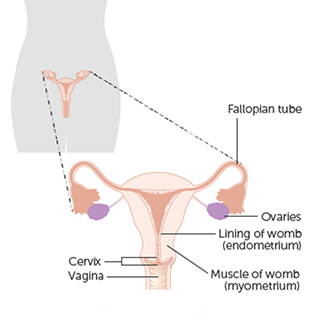Around 13,000 women are diagnosed with womb cancer in the India each year. This makes it the 6th most common cancer in women with an Incidence of 2/100,000.
Endometrial Cancer: Symptoms & Treatment
Endometrial cancer / Womb cancer
Endometrial cancer is the most common type of womb cancer.Cancer of the uterine body, also called endometrial carcinoma, which is more likely to occur in women who are obese, diabetic, or have fewer pregnancies. This arises in the inner lining of the uterus. It is treated primarily with surgery and the role of radiotherapy is to reduce the risk of recurrence following surgery.
Patients who are unfit for surgery for medical reasons, such as uncontrolled diabetes mellitus, obesity, cardiac ailments, are treated with radiotherapy in combination with chemotherapy.
Early-stage endometrial cancer patients require vaginal brachytherapy, ie internal radiotherapy.
Patients with local regionally advanced disease i.e patients who have involvement of the lymph nodes in the pelvis and the paraaortic region receive external beam radiotherapy. This may be administered along with Therapy in high-risk situations.

The womb is part of a woman’s reproductive system. It is the pear shaped muscular bag that holds and protects a growing baby during pregnancy. The reproductive system is made up of the:
- vagina
- womb (uterus)
- neck of the womb (the cervix)
- fallopian tubes and ovaries
- How common it is?
-
- Who gets it?
-
Most women diagnosed with womb cancer have had their menopause. Almost three quarters of cases of womb cancer are in women aged 40 to 74.
Just over 1 in 100 cases (1%) are diagnosed in women under 40.
- Types and grades
-
The type of womb cancer you have depends on the type of cell the cancer started in. The grade gives doctors an idea of how fast growing the cancer is.
Knowing the type and grade of your cancer helps your doctor to decide what treatment you need.
Type 1 and type 2 endometrial cancer
Doctors sometimes divide endometrial cancers into 2 types.
Type 1 cancers are the most common type. They are usually endometrioid adenocarcinomas, and are linked to excess oestrogen in the body. They are generally slow growing and less likely to spread.
Type 2 cancers include uterine serous carcinomas and clear cell carcinomas. These cancers are not linked to excess oestrogen. They are generally faster growing and more likely to spread.
About 95 out of every 100 (95%) endometrial cancers are adenocarcinomas.
Sarcoma of the womb (Uterine Sarcoma)These are cancers that develop from cells in the muscle layer of the womb, rather than the lining. They are a type of soft tissue sarcoma and are much less common than endometrial cancer.
- Stages
-
The stage of a cancer tells you how big it is and whether it has spread. This helps your doctor decide which treatment you need.
Stage 1
Cancer confined to the womb.
Stage 2
Confined to the womb and involving the neck of the womb.
Stage 3
Involving structures around the womb with or without involving the lymph nodes.
Stage 4
Invading the bladder or bowel and distant metastasis.
Symptoms
Learn about the possible symptoms of womb cancer and when to see your doctor.
Common symptoms
The most common symptom of womb cancer is abnormal bleeding from the vagina, especially in women who have stopped having periods (post-menopausal women).
Abnormal bleeding can be:
- vaginal bleeding after the menopause
- bleeding that is unusually heavy or happens between periods
- vaginal discharge – from pink and watery to dark and foul smelling
About 9 out of 10 womb cancers (90%) are picked up because of post menopausal or irregular vaginal bleeding. This is why womb cancer is so often diagnosed early.
Remember – irregular bleeding is a common symptom of many other conditions, such as:
- endometriosis
- fibroids
- thickening of the womb lining (endometrial hyperplasia)
- growths (polyps) in the womb lining
- bleeding with no obvious underlying cause (called dysfunctional uterine bleeding)
Only a small number of women with irregular bleeding will actually have womb cancer. Your doctor might feel that your womb is larger than normal or can feel a lump (mass) in your tummy (abdomen) or pelvis.

Other Gynaecological Cancers



